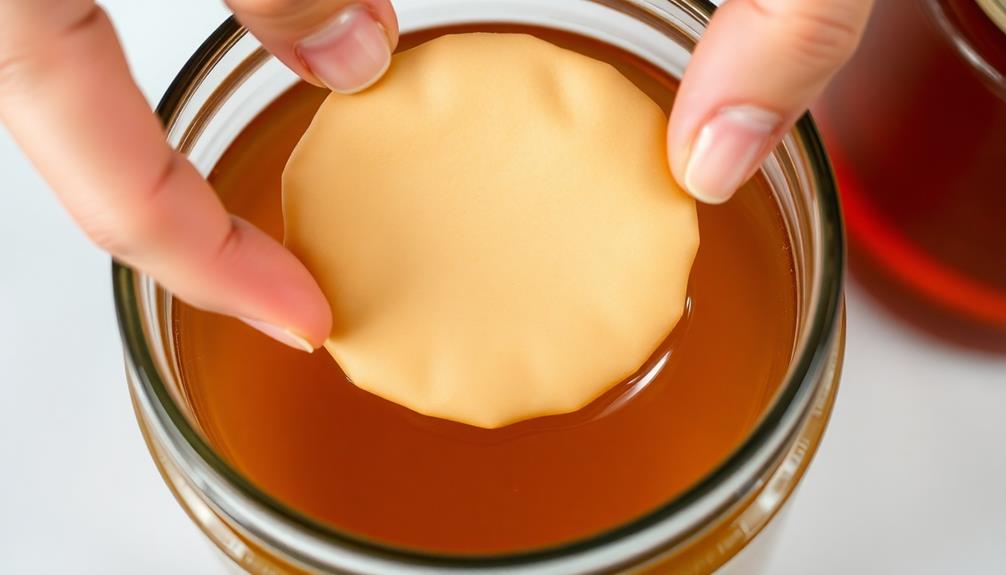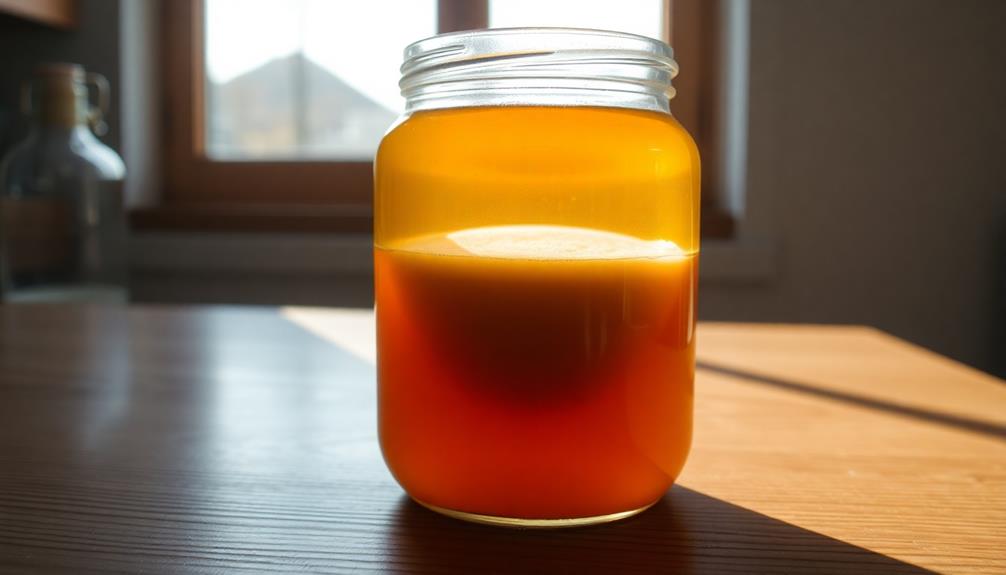Kombucha, the captivating fermented tea, has a fascinating history tracing back to Eastern nations. This effervescent beverage blends a tangy flavor with probiotic benefits that nourish your gut health. To brew it at home, you'll steep black or green tea with sugar, then add a SCOBY culture to kick off the 7-14 day fermentation process. As you monitor the kombucha's transformation, you can experiment with different flavors by adding fruits or spices. The rewards are substantial – kombucha's probiotics support your overall wellbeing, so get ready to savor this delightful drink and discover its endless possibilities.
Key Takeaways
- Kombucha is a fermented tea beverage with probiotic properties that support gut health and overall well-being.
- The brewing process involves fermenting sweetened black or green tea with a SCOBY (Symbiotic Culture of Bacteria and Yeast).
- Home brewing allows for customization of flavors and fermentation control, offering creative opportunities to experiment with different taste profiles.
- Consuming homemade kombucha can provide digestive support and enhance overall gut health due to its probiotic content.
- The versatility of kombucha allows for flavor experimentation by incorporating complementary ingredients like citrus or fruit juices to create personalized variations.
History
Kombucha's origins can be traced back centuries, with its roots firmly planted in the rich histories of Eastern nations. The exact origins are a bit fuzzy, but many believe this fermented tea first emerged in China or Russia, where it was cherished for its purported health benefits.
Over time, the bubbly beverage made its way around the world, gaining popularity in various cultures. In the early 20th century, kombucha started gaining attention in the West. As more people discovered its tangy, slightly sweet flavor and probiotic properties, it became a trendy health drink.
Today, kombucha is enjoyed globally, with home brewers and commercial producers offering a wide variety of flavors and styles. Whether you're new to kombucha or a longtime fan, its fascinating history adds to the joy of sipping this unique fermented tea.
Recipe
Kombucha is a fermented tea beverage that has gained popularity for its potential health benefits, particularly for gut health. Brewing kombucha at home allows you to customize the flavor and control the fermentation process. This recipe provides a step-by-step guide to creating a delicious and nutritious kombucha.
Kombucha is rich in probiotics, which can support digestive health and overall wellness, making it a great addition to your diet. Additionally, like other fermented foods, kombucha may have a positive impact on gut health by promoting a healthy microbiome gut health benefits.
Kombucha is made by fermenting sweetened black or green tea with a symbiotic culture of bacteria and yeast, known as a SCOBY (Symbiotic Culture of Bacteria and Yeast). The SCOBY acts as a starter culture, converting the sugar and tea into a slightly carbonated, slightly acidic beverage rich in probiotics and beneficial acids.
- 4 cups filtered water
- 4 black tea bags or 4 teaspoons loose-leaf black tea
- 1/2 cup white sugar
- 1 SCOBY (purchased or grown from a previous batch)
- 1 cup unflavored kombucha (from a previous batch or store-bought)
To brew the kombucha, bring the filtered water to a boil in a non-reactive pot. Remove from heat and add the tea bags or loose-leaf tea. Steep for 5-7 minutes, then remove the tea. Stir in the sugar until dissolved. Allow the sweetened tea to cool to room temperature.
Once the tea has cooled, pour it into a clean, non-reactive fermentation vessel, such as a glass jar or bottle. Gently slide the SCOBY into the tea, along with the 1 cup of unflavored kombucha. Cover the vessel with a coffee filter or cheesecloth, secured with a rubber band.
Allow the kombucha to ferment at room temperature, out of direct sunlight, for 7-14 days, depending on your desired flavor profile. Taste the kombucha periodically and transfer to a second fermentation vessel once it reaches your preferred tartness.
During the fermentation process, be sure to keep the SCOBY and the brewing environment clean to prevent mold or unwanted bacteria from contaminating the batch. Enjoy your homemade kombucha as a refreshing and gut-healthy beverage.
Cooking Steps
First, you'll steep the tea leaves and sugar in hot water to create the base, ensuring that you select high-quality tea for optimal flavor and fermentation.
Black tea is most commonly used due to its high tannin content, but you can also experiment with green tea for a lighter flavor the benefits of using specific teas.
Then, you'll add your starter culture and let it ferment for 7-10 days.
Step 1. Steep Tea Leaves and Sugar

To begin the kombucha brewing process, you'll need to steep the tea leaves and dissolve the sugar.
First, bring some water to a boil in a pot. Once the water is hot, remove it from the heat and add your favorite black or green tea leaves. Let the tea steep for about 5-10 minutes, allowing the flavors to infuse the water.
Next, you'll need to add some sugar to the tea. The sugar acts as food for the kombucha culture, so it's an essential ingredient. Stir the tea until the sugar completely dissolves.
The amount of sugar you use can vary, but a good rule of thumb is about 1/2 cup of sugar per gallon of tea. Once the sugar has dissolved, let the tea cool to room temperature.
This sweet, flavorful tea is the base of your kombucha. With the tea ready, you can now add the kombucha culture and begin the fermentation process.
Step 2. Add Starter Culture

Adding the starter culture is a crucial step in the kombucha brewing process. This special liquid contains living bacteria and yeast that will transform your sweet tea into the bubbly, fermented beverage we all love.
Don't worry, it's easy to add! Simply pour the starter culture into your brewing vessel, making sure to leave a little room at the top. The starter culture kickstarts the fermentation, allowing the good bacteria to multiply and work their magic.
Over the next 7-14 days, you'll start to see bubbles forming and the liquid taking on a slightly sour, vinegary taste. This means the kombucha is ready! Be patient and let the fermentation do its thing.
With the right starter culture, you'll have a batch of delicious, gut-healthy kombucha in no time. Just remember to save a bit of the finished kombucha to use as the starter for your next batch.
Kombucha brewing is a continuous cycle of healthy, homemade happiness!
Step 3. Ferment for 7-10 Days

Fermenting the kombucha for 7-10 days is the next crucial step. This is when the SCOBY (Symbiotic Culture of Bacteria and Yeast) really gets to work, transforming the sweet tea into the flavorful, fizzy drink you know and love.
During this time, the SCOBY will feed on the sugars in the tea, producing the beneficial acids and probiotics that give kombucha its distinctive taste and health benefits.
Be sure to keep the jar covered with a breathable cloth to allow air circulation while keeping out dust and debris.
Check on your kombucha every few days, gently stirring the liquid. You'll notice the tea becoming more acidic and less sweet as the fermentation progresses.
When it reaches your desired flavor profile, usually around 7-10 days, it's time to bottle your kombucha for the final step.
Resist the temptation to peek too often, as this can slow down the fermentation process. Trust the SCOBY to do its magic and create a delightful, gut-friendly beverage.
Step 4. Transfer Liquid to Bottles

Once the 7-10 day fermentation period has elapsed, you'll want to carefully transfer the kombucha liquid into bottles for the final stage. Use a mesh strainer to separate the liquid from the SCOBY (the symbiotic culture of bacteria and yeast) and any fruit or other additions.
Pour the clear, golden-brown kombucha into clean, sanitized bottles, leaving a bit of headspace at the top. Kombucha is rich in probiotics, which are beneficial for gut health and digestion, making it a great addition to your diet for gut health benefits.
Next, you'll add any flavorings or carbonation you desire. Fruit juices, spices, and herbs are popular options to try.
Seal the bottles tightly and let them sit at room temperature for 1-3 days to build up the carbonation. Keep an eye on them, as the pressure can build quickly!
Once the kombucha has reached your desired fizziness, transfer the bottles to the refrigerator to stop the fermentation process. Enjoy your homemade kombucha over the next few weeks. Cheers to better gut health!
Step 5. Drink and Enjoy Kombucha

With your kombucha now bottled and carbonated, it's time to savor the fruits of your labor. Grab a chilled glass and pour your freshly brewed kombucha. Observe the bubbly, golden liquid, taking in its inviting aroma. Go ahead and take a sip – the tart, slightly sweet flavor dances on your tongue, invigorating your senses.
As you enjoy your kombucha, notice how the fizz tickles your taste buds. The effervescence adds a delightful liveliness to the drink. With each sip, you'll feel the probiotics from the fermentation process nourishing your gut. Kombucha's blend of beneficial bacteria and organic acids promotes a healthy digestive system, leaving you feeling refreshed and energized.
Don't be afraid to experiment with different flavor combinations. Try adding a squeeze of citrus or a splash of fruit juice to complement the kombucha's natural flavors. You might also consider incorporating ingredients like fresh herbs, spices, or even a pinch of sea salt to create a unique twist. For a savory pairing, enjoy your kombucha alongside dishes like pho tron Vietnamese mixed noodles, where the tangy drink can balance the rich, umami flavors. The interplay of textures and tastes will leave your palate intrigued and delighted.
Discover your perfect balance of sweet, tart, and fizzy. Savor every moment, and let the goodness of kombucha uplift your day.
Final Thoughts
Kombucha brewing is a rewarding process that can yield remarkable benefits for your gut health.
Now that you've learned the basics of this ancient fermented tea, it's time to look ahead to the future. As you continue your kombucha journey, remember to have fun and experiment with new flavors. The possibilities are endless!
Whether you prefer a tart and tangy brew or a sweeter, more effervescent version, adjusting the fermentation time and ingredients will allow you to craft your perfect kombucha.
Beyond the taste, the real magic lies in the probiotics and gut-friendly compounds that kombucha provides. Regularly drinking this fizzy elixir can support a healthy digestive system and overall wellbeing.
Frequently Asked Questions
How Long Does Kombucha Need to Ferment?
The length of time kombucha needs to ferment can vary, but typically it takes 7-14 days. You'll want to taste it regularly to get the flavor profile you prefer before bottling and enjoying your homemade kombucha.
Can I Make Kombucha With Regular Tea Bags?
You can make kombucha using regular tea bags, but it may not produce the same complex flavor profile as using loose leaf tea. The SCOBY (symbiotic culture of bacteria and yeast) can still ferment the tea, but the results may be less nuanced.
What Are the Health Benefits of Drinking Kombucha?
Drinking kombucha can provide several health benefits. It's packed with probiotics that support gut health, contains antioxidants that may boost your immune system, and may even aid in weight management. Give it a try to see how it can benefit you.
How Do I Store My Finished Kombucha?
Once you've finished brewing your kombucha, you'll want to store it in the fridge. This will help slow down the fermentation process and keep your drink fresh and flavorful. Just make sure to seal the container tightly.
Can I Add Fruit or Herbs to My Kombucha?
You can absolutely add fruit or herbs to your finished kombucha! This can create delicious flavors and provide additional health benefits. Just be sure to thoroughly clean and prepare your ingredients before adding them to your kombucha brew.










